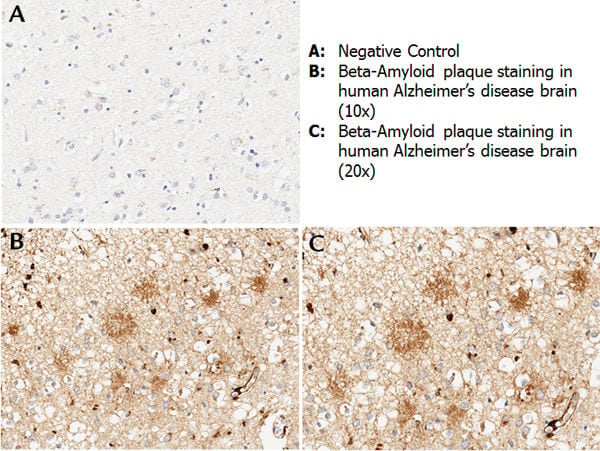The prevalence of Alzheimer's disease (AD), the primary contributor to dementia, increases significantly with age. One of the distinctive features of AD involves the accumulation of extracellular plaque formations containing amyloid-β (Aβ), along with neurofibrillary tangles (NFTs) composed of tau. However, the precise connection between brain aging and the deposition of Aβ remains elusive. A recent publication by Depp et al., 2023 examined whether age-related structural myelin defects are a risk factor for neuronal Aβ deposition.
In this study, the researchers propose a working model, where myelin dysfunction, specifically modeled through the premature aging of white matter in myelin mutant mice, triggers a cascade of events. The dysfunction leads to the activation of microglia, which interferes with the clearance of Aβ deposits and promotes plaque formation. Simultaneously, aging myelin loses its supportive functions for axons, causing axonal distress. This distress leads to increased levels of neuronal BACE1 (Beta-Site App-Cleaving Enzyme) and APP CTF (Amyloid Precursor Protein-derived C-Terminal Fragment), suggesting enhanced Aβ production.
The study highlights the interconnectedness of plaque-promoting factors, microglial activation, and axonal distress as downstream consequences of myelin injury. The researchers emphasize that it is challenging to isolate these phenomena due to their tight linkage. They note that microglia depletion in certain mice models can alleviate axonal swellings, indicating that axonal distress and APP metabolism changes might be downstream of microglia activation. Interestingly, the amyloid-promoting effect observed with myelin dysfunction differs from nonspecific microglia activation induced by lipopolysaccharide, indicating the unique role of myelin defects in microglia activation.
An important clinical implication of the study's findings is the potential connection between AD and multiple sclerosis (MS). The researchers suggest an increased risk of AD as a comorbidity of MS based on their experiments and recently published data. Due to the limited dataset however, further epidemiological studies need to explore this comorbidity.
The findings of this study establish a causal link between myelin deterioration and AD progression, contributing molecular evidence to the existing amyloid hypothesis and the role of neuroinflammation in AD. It positions age-dependent loss of myelin integrity as an upstream initiator of AD pathology, potentially explaining why age is a major risk factor for the disease.

Amyloid-β Pathway Antibodies
| Product | Clonality | Reactivity | Application |
| Amyloid Fibrils (OC) Antibody | Polyclonal | Human | WB, IHC, IF, IP, Other |
| Amyloid Oligomers (A11) Antibody | Polyclonal | Human, Mouse, Rat | WB, IHC, IF, IP, Other |
| APBA2 Antibody | Polyclonal | Human | WB, ELISA, IHC, IF |
| APP Antibody | Polyclonal | Human, Mouse, Rat | WB, ELISA, IHC |
| APP Antibody | Polyclonal | Human, Mouse, Rat | WB, ELISA, IHC, IF |
| APP Antibody | Polyclonal | Human, Mouse, Rat | WB, ELISA, IHC, IF |
| APP Antibody | Polyclonal | Human, Mouse, Rat | WB, ELISA, IHC, IF |
| APPBP2 Antibody | Polyclonal | Human, Mouse, Rat | WB, ELISA, IHC, IF |
| BACE Antibody | Polyclonal | Human, Mouse | WB, ELISA, IHC, IF, Multiplex |
| Beta-Site App-Cleaving Enzyme Antibody | Polyclonal | Human, Mouse, Rat | WB, ELISA, IHC |
| BACE2 Antibody | Polyclonal | Human, Mouse, Rat | WB, ELISA, IHC |
| Beta Amyloid Antibody | Polyclonal | Human, Mouse | WB, ELISA, IHC, IF |
| Beta Amyloid Antibody | Polyclonal | Human, Mouse, Rat, Primate | - |
| Beta Amyloid Antibody | Polyclonal | Mouse, Rat | WB |
| Beta Amyloid 40 Antibody | Polyclonal | Human, Mouse, Rat, Primate | - |
| Beta Amyloid 42 Antibody | Polyclonal | Human, Mouse | WB, ELISA |
| Beta Amyloid pyro E3 Antibody | Polyclonal | Human | WB, ELISA, IF, Dot Blot, Multiplex |
| Beta Amyloid pyro E11 Antibody | Polyclonal | Human, Primate | WB |
| Beta-Site App-Cleaving Enzyme Antibody | Polyclonal | Human, Mouse, Rat | WB, ELISA, IHC |
| Myelin Basic Protein (MBP) Antibody | Polyclonal | Human, Mouse, Rat, Bovine | WB, IF |
Amyloid-β Proteins
References